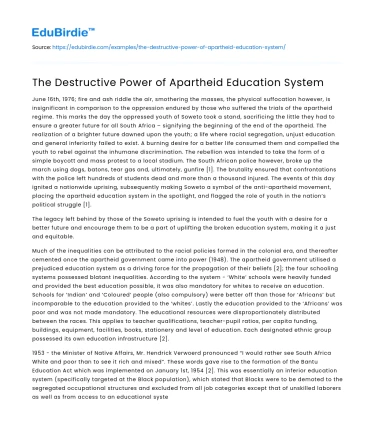June 16th, 1976; fire and ash riddle the air, smothering the masses, the physical suffocation however, is insignificant in comparison to the oppression endured by those who suffered the trials of the apartheid regime. This marks the day the oppressed youth of Soweto took a stand, sacrificing the little they had to ensure a greater future for all South Africa – signifying the beginning of the end of the apartheid. The realization of a brighter future dawned upon the youth; a life where racial segregation, unjust education and general inferiority failed to exist. A burning desire for a better life consumed them and compelled the youth to rebel against the inhumane discrimination. The rebellion was intended to take the form of a simple boycott and mass protest to a local stadium. The South African police however, broke up the march using dogs, batons, tear gas and, ultimately, gunfire [1]. The brutality ensured that confrontations with the police left hundreds of students dead and more than a thousand injured. The events of this day ignited a nationwide uprising, subsequently making Soweto a symbol of the anti-apartheid movement, placing the apartheid education system in the spotlight, and flagged the role of youth in the nation’s political struggle [1].
The legacy left behind by those of the Soweto uprising is intended to fuel the youth with a desire for a better future and encourage them to be a part of uplifting the broken education system, making it a just and equitable.
Save your time!
We can take care of your essay
- Proper editing and formatting
- Free revision, title page, and bibliography
- Flexible prices and money-back guarantee
Much of the inequalities can be attributed to the racial policies formed in the colonial era, and thereafter cemented once the apartheid government came into power (1948). The apartheid government utilised a prejudiced education system as a driving force for the propagation of their beliefs [2]; the four schooling systems possessed blatant inequalities. According to the system - ‘White’ schools were heavily funded and provided the best education possible, it was also mandatory for whites to receive an education. Schools for ‘Indian’ and ‘Coloured’ people (also compulsory) were better off than those for ‘Africans’ but incomparable to the education provided to the ‘whites’. Lastly the education provided to the ‘Africans’ was poor and was not made mandatory. The educational resources were disproportionately distributed between the races. This applies to teacher qualifications, teacher-pupil ratios, per capita funding, buildings, equipment, facilities, books, stationery and level of education. Each designated ethnic group possessed its own education infrastructure [2].
1953 - the Minister of Native Affairs, Mr. Hendrick Verwoerd pronounced “I would rather see South Africa White and poor than to see it rich and mixed”. These words gave rise to the formation of the Bantu Education Act which was implemented on January 1st, 1954 [2]. This was essentially an inferior education system (specifically targeted at the Black population), which stated that Blacks were to be demoted to the segregated occupational structures and excluded from all job categories except that of unskilled laborers as well as from access to an educational system that would enable them to participate with the white population [2]. This demeaned the black population and stripped them of having the possibility of a better future, the ripple effect of this system can still be seen in South Africa today.
When reflecting on the horrid educational history of South Africa, there is glaring evidence that the educational system was ravaged by the apartheid regime. A period of 40 years exists between the implementation of the Bantu education Act and the abolishment of the apartheid – this is 4 decades of injustice; compared to the meagre 20 years of democracy in which the government tries to fix the innumerable wrongs of the past. The youth (including the ‘born free’ generation) of today may still suffer due to the legacy of the Apartheid as inequality is something that has stained the country. Many government schools provide a poor education and parents are unable to send their children to private schools due to poverty - this is where the cycle begins. The unfortunate life cycle caused by the apartheid needs to be broken – in order to do so, South Africa still needs to heal from the wounds of the apartheid and establish a strong foundation for basic education.
The apartheid system served to plant seeds of inequality, hatred, bias and inferiority in the minds of the non-white youth, one may speculate that the apartheid government was driven by fear and intimidation – rightfully so, the minds of the youth (irrespective of race) are powerful, transformative and evidently capable of changing the future.
References
- New Learning, 'Apartheid Education,' 2000. [Online]. Available: http://newlearningonline.com/new-learning/chapter-5/apartheid-education. [Accessed 4 March 2019].
- South African History Online , 'South African History Online,' 2000. [Online]. Available: https://www.sahistory.org.za/archive/bantu-education-boycott. [Accessed 2 March 2019].






 Stuck on your essay?
Stuck on your essay?

